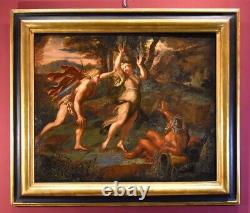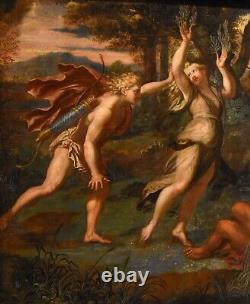
- Index
- Listed By
- Material
- Size
- Style
- Abstract (20)
- Abstract, Modernism (6)
- Americana (5)
- Art Deco (9)
- Art Nouveau (4)
- Art, Realism (4)
- Dutch (4)
- Dutch, Realism (5)
- Expressionism (23)
- Folk Art (9)
- Impressionism (150)
- Impressionist (5)
- Modernism (12)
- Portraiture (6)
- Realism (163)
- Still Life (22)
- Traditional (10)
- Traditional, Realism (4)
- Victorian (18)
- Vintage (58)
- Other (476)
- Subject
- Unit Of Sale
Large Painting Antique Apollo Fangs Oil on Canvas Xvii Century Old Master
















Large Painting Antique Apollo Fangs Oil on Canvas Xvii Century Old Master. The description of this item has been automatically translated. Giovanni Angelo Canini (Rome, 1608 - Rome, 1666) - The myth of Apollo and Daphne. Oil on canvas 84 x 100 cm - framed 106 x 125 cm. The work is accompanied by the expertise of prof. The complete details of this work can be consulted directly from the following - LINKS.' Thank you for bringing to my attention this qualitative and interesting mythological scene oil on canvas, cm.
84 x 100 which refers to an episode narrated by Ovid in his Metamorphoses, precisely the myth of Apollo and Daphne, one of the most famous unrequited loves of classical mythology, an episode taken from ancient Latin culture, and taken up starting from the Renaissance, such a poignant love story with deep symbolic meanings. Daphne, daughter of the river god Peneus, represented below on the right, is pursued by Apollo who, shot by a golden arrow from Cupid, hidden with a mocking smile in the bush, falls madly in love with her. We see him here, pervaded by an irrepressible passion, as he tries in vain to grab the girl who, shot by Cupid himself with a lead arrow, will instead be destined to run away and reject Apollo's love. Exhausted by this continuous flight, Daphne reaches her father, the river-god Peneus, who transforms her into a laurel tree to save her, with her limbs losing their human appearance to become twigs. I have dwelt on the description of this scene because, although it is a subject often taken up in painting starting above all from the second half of the seventeenth century and in the first half of the following, it is very rare to find examples of it so accurate in the details that make aware of the succession of events.
Furthermore, despite the considerable size, typical of an aristocratic picture gallery, it has a clear and well-defined figurative imprint in the contours, together with a vivid pictorial imprint but with frozen colors, which denounce the presence of an author also familiar with the engraving which was probably his main activity together with the constant practice of drawing. In fact, the painting considered here can be traced back to the hand of Giovanni Angelo Canini (Rome 1608 - 1666). A testimony of sure autography that could be linked to the series of works created by Canini for Cardinal Camillo Astaldi, a patron of the arts who in 1645-50 had commissioned him various pictorial decorations with profane subjects (some signed), including "Stories of Rinaldo and Armida ", intended for his Castle Theodoli di Sambuci (near Tivoli), many of which have been lost. Datable to around 1650, the work reflects Canini's emancipation from the initial prevailing stylistic approach based on Domenichino, of which he was a direct pupil until the master's departure for Naples, remaining however tied to his classicistic orbit, but affirming his evident interest also for the upright affirmations of the Baroque. In fact, this present painting, although created with a figurative language that is still strictly classicistic, follows a narrative taste of an already Baroque mold, in the detailed description of the events, in which the human figure still plays a leading role, albeit with clear arboreal elements in the background. With regard to his pictorial activity for private use, unfortunately largely lost or obscured by deviant attributions, it is worth mentioning that Giovanni Angelo Canini had acquired significant credit among the Roman cultural elite, thanks to the close esteem relationships with regina Christina of Sweden, as well as the documented relations with the Savoy court.The conservation conditions of the work appear to be good. If you would like to see this or other works in person, we will be happy to welcome you to our new gallery in Riva del Garda, in Viale Giuseppe Canella 18. We are waiting for you! We see him here, pervaded by an irrepressible passion, as he tries in vain to grab the girl who, shot by Cupid himself with a lead arrow, will instead be.
Giovanni Angelo Canini (Roma, 1608 - 1666).

